Thinkific vs kajabi: Which is best for you?
You might have a remarkable course idea, but there’s one crucial step that course creators stumble with — finding the right platform! And, after reading a bunch of blogs on the top course-selling platforms, you would have come across two remarkable platforms: Thinkific and Kajabi. So, that brings us to the Thinkific vs Kajabi debate!
Yes, they are the two most prominent names in online course creation! Both platforms have everything it takes to build, market and sell your course. However, despite their similarities, they have different value propositions. So, it typically comes down to what you offer and who your target audience is!
In this blog, we delve deep into how the two platforms work and compare them head to head on some significant points. So, let’s understand how these platforms fare and which is ideal for your course creation!
What is Thinkific?
Thinkific is an “all-in-one course-building platform” that helps anyone deliver courses through their branded website. The platform’s user-friendly interface makes it a popular choice among course creators. Whether you are an entrepreneur, podcaster, or author, Thinkific’s simplistic design and ease-of-use makes course creation a breeze!

So, who is their ideal audience?
Thinkific is a beginner-friendly course creation platform with a limited free plan. It is primarily a course platform for course creators focussing on learning experiences rather than growing your business. Simply put, Thinkific is a worthy investment for creating, managing, and selling your courses.
Features
- Easy Website-Builder
- Good LMS
- Course Website/ Landing Page
- Assignments
- Quizzes
- Course Completion Certificates
- Learner Progress Tracking
- Drip Courses
- Secure Payment Processing
- Automated Email Sequences
- Native Mobile App
What is Kajabi?
Kajabi is a well-rounded course platform that allows creators to sell courses, coaching and memberships. So, it caters to a broad audience, including course creators, instructors, digital entrepreneurs, SMEs, etc. Most importantly, Kajabi extends beyond the course creation tag towards marketing and sales.

In short, it is “home to your entire business”! It’s an amalgamation of everything your business needs—websites, course authoring, built-in email marketing, sales pipeline, building, and landing pages. So, the platform is priced slightly higher. However, considering the range of features it delivers, its price comes across as reasonable.
Kajabi is ideal for course-creators who are looking to sell multiple services and avail all in one comprehensive software.
Features
- Wide range of products from courses, memberships, coaching, etc
- Course Templates
- Landing Pages
- Built-in marketing tools
- Sales Pipeline Building
- Payment processing & Integrations
- Online Community Feature
- Analytics
- Webinars
- Chat Support
- Kajabi University Training
Thinkific vs Kajabi
While both platforms describe themselves as “all-in-one” course platforms, as a course creator, it is essential to find the major distinctions to find your best fit!
Comparing both platforms altogether could be overwhelming, so we pulled out the major points to draw a comparison.
1. Course Creation and Delivery
Let’s start with the most elementary aspects—course creation and delivery. Both Kajabi and Thinkific provide features to develop an engaging course through an easy drag-and-drop course builder. You can build a comprehensive curriculum that includes multiple media, such as text, audio, PDFs, videos, etc.
Additionally, both platforms allow you to create and upload unlimited courses with different bundles, upsells and popular payment options!
Thinkific
Thinkific helps to transcend your knowledge into courses with its top-notch course creation tools. It has a user-friendly interface for course structuring, custom web themes and domains. Thinkific’s intuitive course builder offers flexible course creation and editing options.
Every course includes different chapters, which are further categorized into separate lessons. A lesson could be anything from a quiz, survey, assignment or presentation.
Simply put, Thinkific is primarily a course platform for educators who intend to offer comprehensive courses. However, Thinkifc doesn’t allow multi-currency support, so it might not be a viable solution for a global business.

Kajabi
Kajabi offers diverse products, including courses, memberships, and coaching programs. With its ready-to-use templates, course creation is never an upheaval task! Kajabi has an apt course template for every use case, including mini-courses, drip courses, online courses, memberships, etc.
Like Thinkific, a course is divided into different modules consisting of lessons or posts. Each post or lesson could be either an audio, video, text or a downloadable file. Kajabi offers the freedom to build your own brand by adding your personalized logo, customized theme, and custom domain.

2. Website Builder
Selling courses from your own website is a great way to maximize your profits. It brings in more ownership over your website: choosing the design, templates and custom themes. Both Thinkific and Kajabi have an easy website builder and allow you to host your domain without any third-party platform dependency.
Thinkific
With Thinkific’s intuitive drag-and-drop site builder, building a professional website is effortless! It easily allows you to add new sections, customize page elements, and deliver content in an impactful way. From the homepage and courses to bundles and default pages, you can customize every aspect of your website within a few clicks!

Further, you can add new sections like countdown timers, checklists, engaging CTAs with images and texts, FAQs, and other specific categories. Apart from the homepage, the site builder allows you to modify other pages and even add landing pages for courses.
Speaking about the downsides, Thinkific doesn’t allow you to set up blogs and your website in one place. Instead, you can set up blogs on another website and link them to your courses.
Kajabi
If you thought you needed to be a coding wizard to build your own website, you are mistaken! With a website builder like Kajabi, you don’t need coding skills and can design a professional website effortlessly!
Kajabi’s USP is its unique collection of customized landing page templates. You can change every aspect of your landing page, including CTAs, images, columns, etc.

Moreover, Kajabi offers a more specific theme to suit your offering. For example, if you are selling a digital product, you can choose a specialized theme for your product rather than a course-based theme.
3. Marketing Tools
Once you craft a compelling course, your job doesn’t end here! You must know how to market your online courses. Without a few bounds of marketing and upselling, your course might not sell. Embedding marketing and sales within a course creation platform is a desirable feature.
So, let’s see which platform excels in this facet.
Thinkific
This amazing course-selling platform offers a variety of tools for course promotion and driving sales through different channels. Coupons, custom widgets for course promotion on your website, and free lessons are some of the marketing features Thinkific offers.

As you know, Thinkific has an easy-to-use website builder for creating course-selling websites. It also allows you to create landing pages to upscale your email marketing campaigns and attract leads. Besides, you can create affiliate programs for your course.
However, Thinkific offers coupons and affiliate selling in its basic plan, not in the free version.
Kajabi
Kajabi is a complete online business software that extends itself beyond the course-selling label and helps your business thrive! And yes, marketing is undoubtedly one arena where Kajabi shines!

Let’s take a look at the fantastic marketing features the platform offers:
- Landing Pages: The customizable landing page comes in different presets, such as high-conversion sales pages, squeeze pages, homepages, download pages, etc.
- Pipelines: They are fully integrated sales funnels. Don’t know how to build a sales pipeline? Just leverage Kajabi’s pipeline feature and see how the magic works! All you have to do is choose a pipeline blueprint, title it, upload your free PDF and write a catchy email.

Furthermore, it also offers other marketing features like A/B testing, coupons, etc.
4. Email Marketing and Automation
As a course creator, marketing is about growing your email list and building long-term relationships! Let’s see which platform edges ahead as a comprehensive course-selling platform in this aspect.
Thinkific
With Thinkific, course creators can send email broadcasts and engage with their prospective customers. However, it lacks native email marketing services like email sequences and pipelines. Instead, it seamlessly integrates with third-party email marketing tools like MailChimp, ConvertKit, etc to perform these functions.
Kajabi
On the other hand, Kajabi includes both automated email sequences and broadcasts.
So, how do email sequences and email broadcasts differ? Email sequences are triggered when a user completes a specific action, like viewing a particular page of a form completion. Typically, a series of messages are sent on a fixed schedule. These email sequences offer value to the customer and help to build your authority!
In contrast, email broadcasts are one-off messages sent to a specific audience. E.g., Newsletters or email blasts. Both email marketing techniques are intended to build trust and win a purchase request!
5. Learning Experience
Now, let’s consider one essential question—who is the primary audience while selling courses? Obviously, the learners are the ones who fuel your platform! A rich learning experience defined by ease of use, assessments, certificates, and communities can go a long way toward driving your platform’s growth.
Let’s compare how both platforms score points from a learner’s perspective!
Thinkific
The platform prioritizes its learning experience more than anything else. Given its intuitive user interface and ease of use, Thinkific definitely comes across as a beginner-friendly platform. From course enrollment to learning communities, the platform delivers a distraction-free user experience!
Let’s evaluate the platform on the following metrics:
- Course Enrollment: Thinkific guides you through a seamless enrollment process! First, learners sign up for a user account, purchase the product, and access it through the student dashboard.
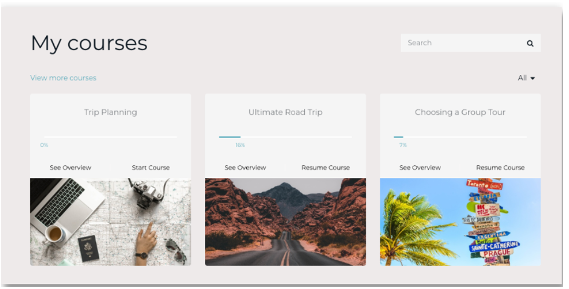
- Course Player: It is the course-taking environment where students typically access their courses, watch videos, attempt quizzes, etc. Thinkific offers an interactive course player where you can opt for customizations.

- Live Lessons: Thinkific offers interactive live lessons via Zoom meetings or webinars.
- Assessment: Thinkific allows students to be assessed through dynamic quizzes, surveys, assignments, and Brillium exams. Quizzes include multiple-choice questions with a single correct answer or multiple correct answers.

- Certificates: With Thinkific, you can reward a learner for successfully completing a course. You can choose from Thinkific’s existing templates or upload your customized background image. Here, you can add fields like student name, course completion, expiry date, etc.

- Learning & Community: Thinkific Communities are a remarkable feature that helps students connect on a specific topic. Understanding how to create a learning community helps to incentivize your learners to achieve their goals.

Kajabi
Kajabi provides all that Thinkific provides as a learning platform, plus it allows creators to host coaching and live sessions within the platform. So, overall, the platform delivers a power-packed learning experience!
Let’s gauge Kajabi’s learning experience on the following points:
- Course Player: Kajabi’s advanced course player provides a seamless learning experience to its students. You can customize the video with different themes or change its alignment to inline or full screen.
- Assessments: Kajabi allows users to create assessments like tests or survey tools. You can engage, collect information and assess the learner’s knowledge and track their progress.
- Certificates: Reward learners with certificates for 100% completion of a course, particular lesson, or specific assessment. You can include the certificate title, student name, course subtitle or any other custom field.

- Coaching and Live Video Sessions: Kajabi allows you to host interactive and engaging live video sessions through Kajabi’s built-in live video feature. This helps to offer a complete coaching experience!

- Learning Community: Build a place for customers to meet, learn and collaborate with Kajabi communities. These communities come with news feeds, chats, DMs, challenges, video calls, resources, events, etc.
6. Payment Gateway
No matter how compelling your course is, you won’t find any buyers if your platform doesn’t offer a convenient payment infrastructure. Both Thinkific and Kajabi allow built-in payment gateway integration with Stripe or PayPal.
Thinkific
Thinkific supports its default payment processor, Thinkific Payments, and third-party integrations like Stripe or Paypal. The Thinkific native payment gateway is the default processor in the USA, UK and Canada. Customers residing in other countries can use third-party payment processors.
Customers can also make subscriptions, one-time payments, and digital wallets. Thinkific allows PayPal payment on one-time sales but not for subscriptions.
Kajabi
Kajabi allows payment integrations with two popular gateways: Stripe and PayPal. Students can pay using credit cards via Stripe or use their PayPal accounts. Kajabi’s Paypal is more flexible, as it allows students to pay for both one-time and recurring payments(subscriptions).
7. Pricing
Now that you are familiar with the features and functionalities of both platforms, it’s time to compare the pricing plans. Cost is undeniably an essential factor that influences your course-platform selection decision. Pricing depends on the number of users, product features, and other factors.
Thinkific
Thinkific comes across as a cost-effective solution, considering the free version and the price range for higher plans. Its pricing plan reflects its beginner-friendly model. Although the platform offers a free plan, its basic start and grow plan offers additional features to accelerate business growth.
Here’s a quick rundown on Thinkific’s different pricing plans:
- Free Plan – Test-drive Thinkific for free. Includes drag-and-drop course builder, easy-to-use website themes, eCommerce tools, quizzes and surveys, Thinkific Academy course, etc.
- Basic ($49/ month) – Includes core and crucial tools for launching your online business.
- Start ($99/ month) – Additional features for driving engagement and enhancing the learning experience.
- Grow ($199/ month) – Advanced tools to drive sales and diversify into multiple learning products.

All its plans allow unlimited students and courses. Additionally, annual subscriptions offer a 25% discount.
Kajabi
Compared to Thinkific, Kajabi surely appears to be on the expensive side. And Kajabi doesn’t offer a free plan to its customers. However, all its plans come with a 30-day free trial period.
Kajabi’s basic plan starts at $119/ month, and its most popular growth plan is $159/month. Its Pro plan is in a higher price bracket at $319/month.
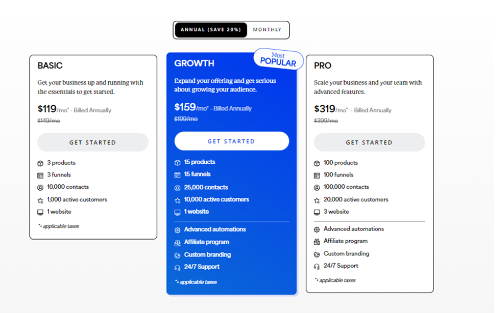
However, these prices are justified considering the extensive marketing and sales tools Kajabi offers. Also, an important point to note here is that Thinkific largely relies on popular third-party tools for extensive email marketing. So, taking into account your spending on third-party email marketing tools, the overall cost would be the same!
8. Customer Support
Excellent customer support is essential, especially as user experience matters so much in today’s digital age! Both Thinkific and Kajabi offer customer support, but let’s see how far they can resolve issues.
Thinkific
The platform offers extensive customer service with its round-the-clock support team. The first level of support is through Thinkific’s chatbot called Champ accessible through the admin dashboard.
Next in line comes the live chat support, where a human agent connects with the customer and fixes the issue. This feature is available on the basic plan and above. Customers can even schedule a call with experts for a more personalized level of support. This is available on the grow plan and above.
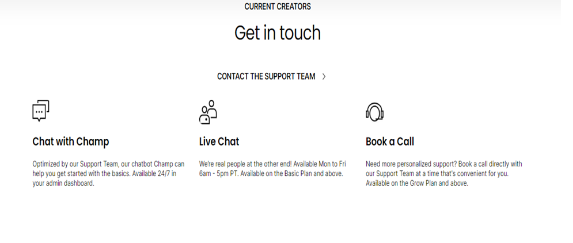
Although Thinkific has largely garnered positive reviews for customer support, Kajabi races ahead slightly!
Kajabi
Like Thinkific, Kajabi offers customer support through live chat or email. If you have a basic Kajabi plan, you can access the live chat on business days from 6 a.m. to 5 p.m. Pacific time. With Kajabi’s growth and Pro plans, you can avail of 24×7 live chat support. Outside business hours, you can reach out by submitting a request.

Kajabi University is a comprehensive training resource that offers all the information needed to build and sell courses. It includes detailed courses for stepping up your online business. Further, Kajabi also offers live and on-demand training webinars to scale up your content creation process.
9. Reporting & Analytics
An important part & parcel of course creation and selling is performance tracking and analysis. It clearly defines where your course stands and how to scale your business further. You can track the progress of the course, students and the platform as a whole!
Thinkific
Thinkific’s analytics dashboards help course creators make informed decisions based on metrics like engagement, course enrollments, and overall revenue. You can even drill down to get a specific result or export a full or partial dataset.
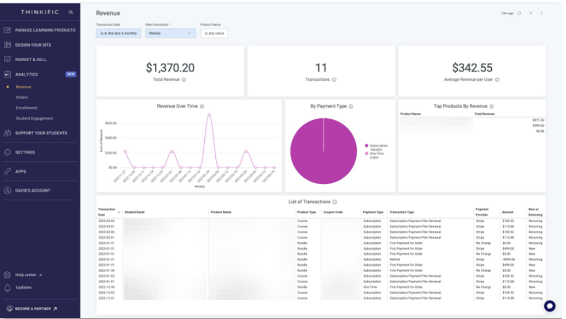
Listed below are Thinkific’s different dashboards offering valuable insights:
- Revenue Dashboard
- Enrollments Dashboard
- Orders Dashboard
- Engagement Dashboard
Kajabi
Besides its extensive marketing, another standout feature that Kajabi offers is its in-depth analytics reports. These reports cover performance across a wide range of metrics, such as churn rates, page views, revenue, etc. Further, the platform also integrates with third-party integrations like Google Analytics, Facebook Pixel, etc.
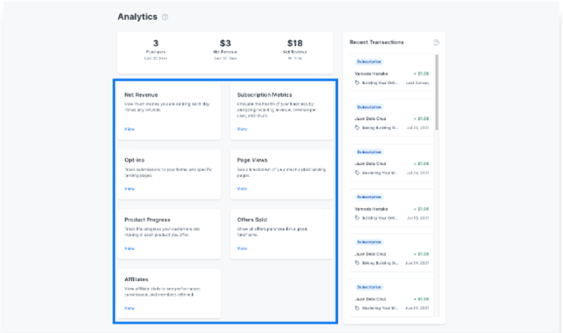
The platform’s advanced analytics allows you to gauge performance on the following metrics:
- Net revenue
- Page reviews
- Subscriptions metrics
- Opt-ins
- Product Progress
- Offers Sold
- Affiliates
10. Native Mobile Apps
Considering the widespread adoption of the internet and the accessibility of mobile apps, mobile apps have evolved as a necessity. Both Thinkific and Kajabi provide their mobile apps for users.
Thinkific
Thinkific offers mobile applications to its Android and iOS users. The feature is included in Thinkific’s Start and Grow plans. The mobile app allows creators to reach their target audience anywhere and anytime! Moreover, it makes the course content and resources more accessible to learners on their coveted devices.
Kajabi
Likewise, Kajabi’s mobile app is available to both Android and Apple users. Learners get easy access to the platform’s key aspects, such as courses, memberships, coaching programs,etc. The app also notifies users about a new product release or tagged notification, enriching the user experience.
Kajabi vs Thinkific: Which is the Better Platform?
Given their extensive features, both Kajabi and Thinkific are excellent course-selling platforms. However, as a course creator, it is essential to understand what you are looking for in your course platform. Are you looking for a user-friendly platform for creating and selling your courses? Are you seeking an all-in-one marketing platform to sell different digital products?
Thinkific is primarily designed for educators who want to offer an impactful learning experience. It has an easy-to-use interface for course creation and selling, a professional website builder, and an amazing learning community feature. However, it lacks the extensive marketing features that Kajabi offers.
On the other hand, Kajabi offers everything in one place! From course creation and selling to marketing strategies like email sequences, there’s no looking back! Despite its higher price bracket, its rich feature set makes it a worthy investment!
Both Thinkific and Kajabi charge a monthly or annual subscription for access to the platform. But if you are looking beyond the Thinkific vs Kajabi debate, for a one-time platform fee, ready-made clone scripts like Pinlearn are a better option!
Why Choose Pinlearn as Your Course-Selling Platform?
Pinlearn is a self-hosted and white-labeled software with an excellent course management feature. The software comes with an open-source code, reducing the dependency on script vendors for customization. Thus, you can build a professional website that aligns with your course-selling needs and redefine your brand.
Besides, Pinlearn offers affordable pricing in two plans: starters and professionals. The starter plan is $699 and includes all the core functionalities minus the open-source code access. The professional plan costs $1499 and includes all the features from the starters plan, along with open-source code access.
Here’s why Pinlearn should be your course-selling platform:
- An easy-to-use course management software to create, upload, sell and track your courses.
- Live tutoring sessions via Zoom and LessonSpace integration.
- Built-in support for popular payment gateways like Paypal and Stripe.
- Create a multi-tier course curriculum with different media types like PDF, audio, video and images.
- Advanced tutor analytics dashboards to evaluate the total number of free and paid courses, course enrollments, revenue, etc.
- Diverse monetization channels like standardized and tutor-specific commission rates.
- Provide discount coupons for free and paid courses.
So, if you are seeking an affordable course-selling platform that is comparable with Thinkific and Kajabi, Pinlearn is the right choice! For more details, contact our support team!
FAQs-Related to Thinkific vs Kajabi
1. Does Kajabi only allow selling courses?
With Kajabi, you can sell courses, memberships, digital products, coaching programs, etc.
2. Is Thinkific a free course-selling platform?
Thinkific offers a free plan with minimal features for beginners, and its paid plan starts at $36/ month. For advanced features, you can avail the Start and Grow plan.
3. Can I build a website with Kajabi?
Kajabi offers an easy-to-use website builder to create powerful course-selling websites. You can also connect your existing website to Kajabi Pages.




